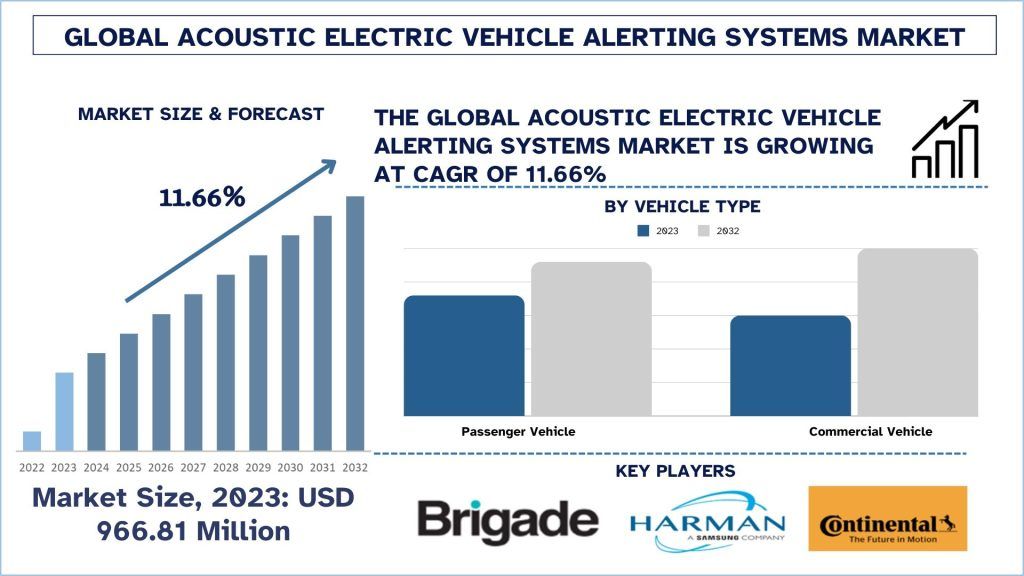- Home
- Chi siamo
- Settore
- Servizi
- Lettura
- Contattaci
Mercato dei sistemi di allerta acustica per veicoli elettrici (AEVAS): analisi attuale e previsioni (2024-2032)
Enfasi sul Tipo di Veicolo (Veicoli Passeggeri e Veicoli Commerciali); Tipo di Propulsione (Veicoli Elettrici a Batteria, Veicoli Elettrici Ibridi Plug-in e Veicoli Elettrici a Celle a Combustibile); Canale di Vendita (OEM e Aftermarket); e Regione/Paese
Dimensioni e previsioni del mercato dei sistemi di avviso acustico per veicoli elettrici
Il mercato dei sistemi di avviso acustico per veicoli elettrici è stato valutato a 966,81 milioni di dollari nel 2023 e si prevede che crescerà a un CAGR costante di circa l'11,66% durante il periodo di previsione (2024-2032), grazie alla crescente adozione di veicoli elettrici, alle rigide normative governative, ai progressi tecnologici e allo sviluppo di veicoli autonomi.
Analisi del mercato dei sistemi di avviso acustico per veicoli elettrici
Il sistema di avviso acustico per veicoli elettrici (AVAS) è un dispositivo acustico che produce un suono simile a quello di un veicolo ICE convenzionale a una velocità fino a 30 chilometri orari quando si muove in avanti e fino a 6 chilometri orari quando si fa retromarcia. In questo modo, il pubblico può essere informato tramite un suono piacevole che un autobus completamente elettrico è vicino o già nella zona. I governi di tutto il mondo stanno implementando varie leggi e le normative sulla sicurezza dei veicoli elettrici sono tra le più importanti. Allo stesso modo, i veicoli elettrici con motore a combustione non producono suoni durante il funzionamento, di conseguenza, i pedoni non sono consapevoli dei veicoli che li circondano. Per garantire la sicurezza dei pedoni, i governi stanno rendendo obbligatoria l'installazione di sistemi di avviso acustico per veicoli che producono suoni e avvisano i pedoni della presenza di veicoli a trazione elettrica. Ad esempio, dal luglio 2019, l'Unione Europea ha reso obbligatorio per tutti i veicoli elettrici di nuova concezione, come i veicoli elettrici a batteria, i veicoli elettrici ibridi e i veicoli elettrici a celle a combustibile, il montaggio di un sistema di avviso acustico. Pertanto, con la crescente domanda di veicoli elettrici, la domanda di sistemi di avviso acustico per veicoli continua a crescere nel periodo di previsione.
Tendenze del mercato dei sistemi di avviso acustico per veicoli elettrici
Generazione adattiva e consapevole del contesto sonoro
La generazione adattiva e consapevole del contesto sonoro è un importante progresso nei sistemi di avviso acustico per veicoli (AVAS). Questa tendenza implica la creazione di sistemi attrezzati per ottimizzare il suono in base alle caratteristiche temporali e spaziali dell'ambiente e alle situazioni del traffico.
Le implementazioni recenti mostrano il rapido avanzamento di questa tecnologia:
Per l'Ariya, un nuovo crossover elettrico, Nissan ha lanciato il suo sistema audio ‘‘Canto’’ nel 2021. L'implementazione di questo sistema dipende dalla velocità, dall'accelerazione e dalla decelerazione del veicolo nella tonalità e nel volume degli avvisi per ridurre l'invadenza del sistema uditivo.
Nel 2022, il suono elettrico caratteristico di BMW, creato da Hans Zimmer, è stato introdotto nei modelli BMW i4 e BMW iX. Questo sistema dipende non solo dalla modalità di guida, ma anche dal territorio adiacente, in quanto il livello sonoro aumenta nelle grandi città e diminuisce in campagna.
I seguenti esempi recenti rivelano come la tecnologia in crescita adattiva di AVAS migliori la sicurezza, riduca i disturbi del rumore e diventi più saggia e contestualmente più efficace di prima. Tale sviluppo non potrà che continuare, con un'integrazione ancora più complessa dei sensori del veicolo e del rilevamento ambientale per migliorare l'efficienza del funzionamento sia per la sicurezza dei pedoni sia per il rispetto del rumore cittadino.
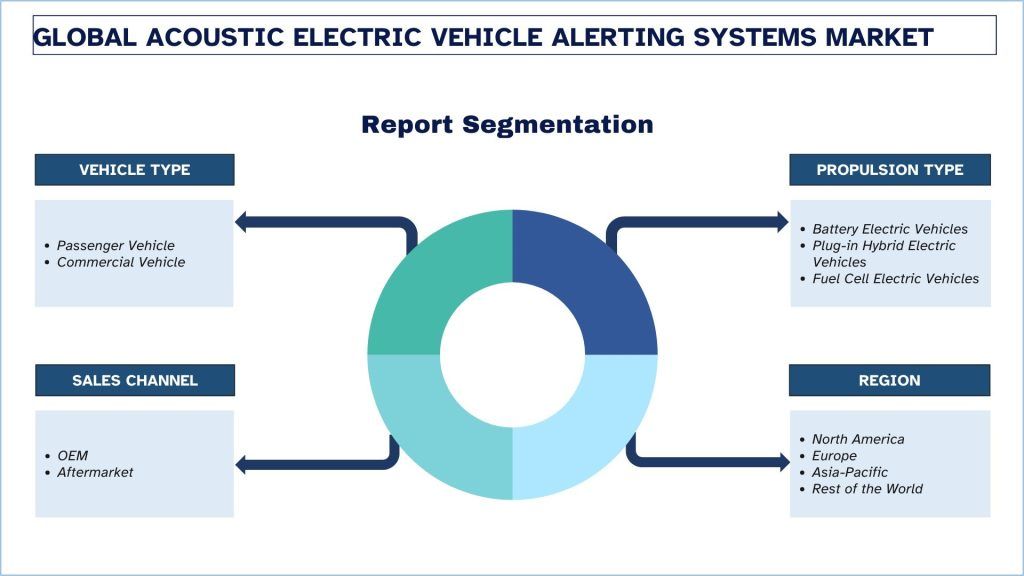
L'Asia Pacifico ha dominato il mercato dei sistemi di avviso acustico per veicoli elettrici
Si prevede che il mercato dei sistemi di avviso acustico per veicoli elettrici dell'Asia Pacifico dominerà nel periodo di previsione. L'industria automobilistica in Asia Pacifico è migliorata notevolmente grazie a un aumento dei percettori di reddito medio e a un miglior reddito pro capite. Cina, India e Indonesia hanno registrato drastici aumenti nelle vendite di auto, alcuni dei quali hanno registrato tassi di crescita a due cifre nel recente passato. Questa maggiore domanda è stata un catalizzatore per i sistemi di avviso acustico per veicoli che sono sottosistemi essenziali nelle automobili attuali. Inoltre, tutti i governi della regione hanno esteso enormi incentivi per sostenere l'industria automobilistica attraverso vari schemi e politiche. Ad esempio, le autorità cinesi hanno rafforzato gli obiettivi politici per sostenere la tassazione liberale e i sussidi, come la fornitura di incentivi fiscali premium per lo sviluppo di auto elettriche (EV). Questo ha reso alta la domanda di EV in Cina, rendendola il leader di mercato nel mondo. Ad esempio, nel 2024, secondo il rapporto pubblicato dall'IEA (International Energy Agency), in Cina sono stati venduti un totale di 8,1 milioni di veicoli elettrici nel 2023, rispetto ai 5,9 milioni del 2022. Inoltre, lo sviluppo tecnologico e l'innovazione hanno contribuito in egual misura all'espansione del mercato della regione Asia Pacifico.
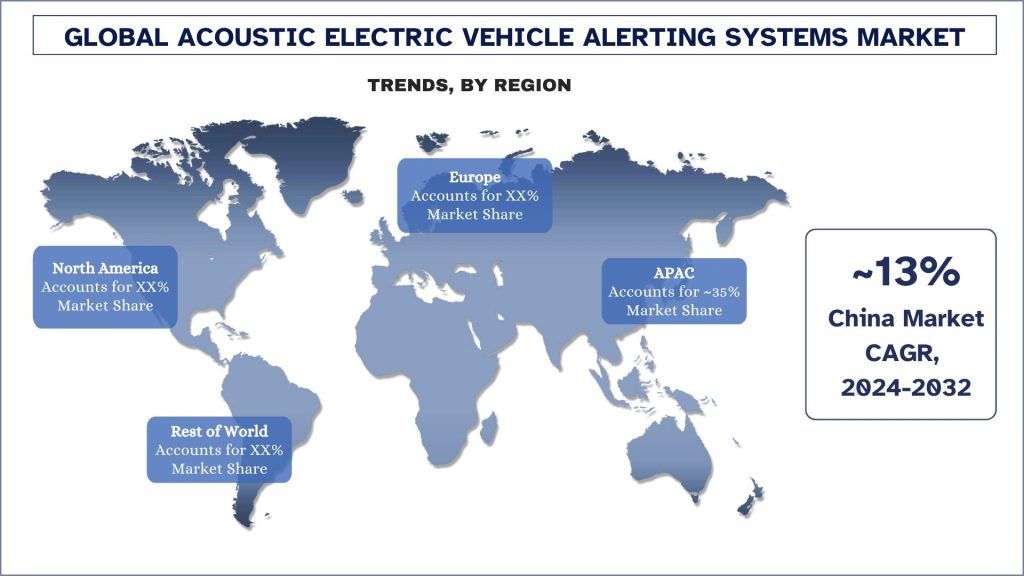
Panoramica del settore dei sistemi di avviso acustico per veicoli elettrici
Il mercato dei sistemi di avviso acustico per veicoli elettrici è competitivo e concentrato, con pochi attori globali e internazionali. Gli attori chiave stanno adottando diverse strategie di crescita per migliorare la loro presenza sul mercato, come partnership, accordi, collaborazioni, lanci di nuovi prodotti, espansioni geografiche e fusioni e acquisizioni. Alcuni dei principali attori che operano nel mercato sono Brigade Electronics Group Plc, HARMAN International, Continental AG, Texas Instruments Incorporated, DENSO ELECTRONICS CORPORATION, HELLA GmbH & Co. KGaA, THOR, STMicroelectronics, Daimler Truck AG e ESI Group.
Notizie sul mercato dei sistemi di avviso acustico per veicoli elettrici
Nel 2024, Brose ha lanciato un nuovissimo AVAS (Acoustic Vehicle Alerting System) che produce un falso suono di guida quando si viaggia a una velocità inferiore a 50 km/h. In questo modo, lo specialista in meccatronica è stato in grado di fare leva sul suo know-how nei settori dell'acustica e dell'elettronica, ad esempio, basandosi sulla progettazione di casse acustiche per moduli porta. Un altro vantaggio è che il modulo ha un'ampia gamma di frequenze da 200 a 5.000 hertz che consente la creazione di suoni vividi e modelli sonori specifici.
Nel 2022, Brigade Electronics ha lanciato Sidescan Predict, la prossima generazione di sistemi di sensori di rilevamento laterale. Il sistema è progettato in particolare per evitare collisioni tra veicoli stradali, oggetti e utenti vulnerabili della strada.
Ad esempio, dal luglio 2019, l'Unione Europea ha reso obbligatorio per tutti i veicoli elettrici di nuova concezione, come i veicoli elettrici a batteria, i veicoli elettrici ibridi e i veicoli elettrici a celle a combustibile, il montaggio di un sistema di avviso acustico.
Copertura del rapporto sul mercato dei sistemi di avviso acustico per veicoli elettrici
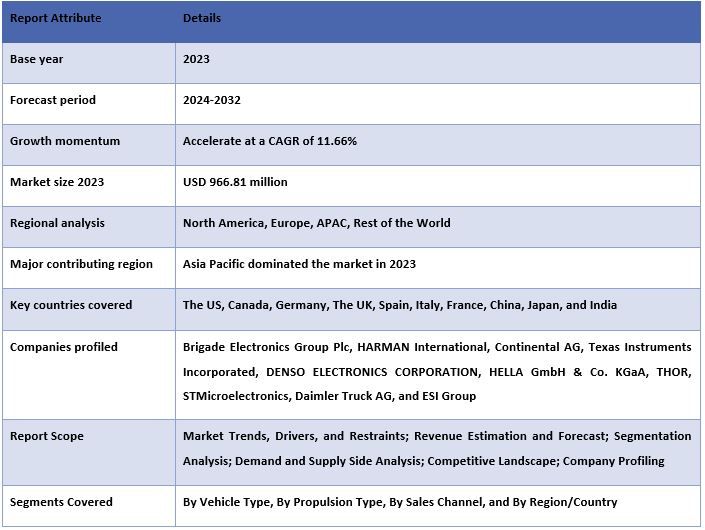
Motivi per acquistare questo rapporto:
- Lo studio include l'analisi delle dimensioni del mercato e delle previsioni convalidate da esperti chiave del settore autenticati.
- Il rapporto presenta una rapida panoramica delle prestazioni complessive del settore a colpo d'occhio.
- Il rapporto copre un'analisi approfondita dei principali concorrenti del settore con un focus primario sui principali dati finanziari aziendali, portafogli di prodotti, strategie di espansione e sviluppi recenti.
- Esame dettagliato dei fattori trainanti, dei vincoli, delle tendenze chiave e delle opportunità prevalenti nel settore.
- Lo studio copre in modo completo il mercato attraverso diversi segmenti.
- Analisi approfondita a livello regionale del settore.
Opzioni di personalizzazione:
Il mercato globale dei sistemi di avviso acustico per veicoli elettrici può essere ulteriormente personalizzato in base alle esigenze o a qualsiasi altro segmento di mercato. Oltre a questo, UMI comprende che potresti avere le tue esigenze aziendali, quindi non esitare a contattarci per ottenere un rapporto che si adatti completamente alle tue esigenze.
Indice
Metodologia di ricerca per l'analisi del mercato dei sistemi di allarme acustici per veicoli elettrici (2024-2032)
L'analisi del mercato storico, la stima del mercato attuale e la previsione del mercato futuro dei sistemi di allarme acustici per veicoli elettrici a livello globale sono stati i tre passaggi principali intrapresi per creare e analizzare l'adozione di sistemi di allarme acustici per veicoli elettrici nelle principali regioni del mondo. È stata condotta un'esaustiva ricerca secondaria per raccogliere i dati storici del mercato e stimare le dimensioni attuali del mercato. In secondo luogo, per convalidare queste informazioni, sono stati presi in considerazione numerosi risultati e ipotesi. Inoltre, sono state condotte anche interviste primarie esaustive con esperti del settore lungo tutta la catena del valore del mercato globale dei sistemi di allarme acustici per veicoli elettrici. Dopo l'assunzione e la convalida dei dati di mercato attraverso interviste primarie, abbiamo impiegato un approccio top-down/bottom-up per prevedere le dimensioni complete del mercato. Successivamente, sono stati adottati metodi di ripartizione del mercato e di triangolazione dei dati per stimare e analizzare le dimensioni di mercato dei segmenti e sottosegmenti del settore di pertinenza. La metodologia dettagliata è spiegata di seguito:
Analisi delle dimensioni storiche del mercato
Passaggio 1: Studio approfondito delle fonti secondarie:
È stato condotto uno studio secondario dettagliato per ottenere le dimensioni storiche del mercato dei sistemi di allarme acustici per veicoli elettrici attraverso fonti interne all'azienda, come relazioni annuali e bilanci, presentazioni sulle prestazioni, comunicati stampa, ecc., e fonti esterne, tra cui riviste, notizie e articoli, pubblicazioni governative, pubblicazioni dei concorrenti, rapporti di settore, database di terze parti e altre pubblicazioni credibili.
Passaggio 2: Segmentazione del mercato:
Dopo aver ottenuto le dimensioni storiche del mercato dei sistemi di allarme acustici per veicoli elettrici, abbiamo condotto un'analisi secondaria dettagliata per raccogliere informazioni storiche sul mercato e sulla quota per diversi segmenti e sottosegmenti per le principali regioni. I segmenti principali inclusi nel rapporto sono tipo di veicolo, tipo di propulsione e canale di vendita. Inoltre, sono state condotte analisi a livello di paese per valutare l'adozione complessiva di modelli di test in quella regione.
Passaggio 3: Analisi dei fattori:
Dopo aver acquisito le dimensioni storiche del mercato di diversi segmenti e sottosegmenti, abbiamo condotto un'analisi dettagliata dei fattori per stimare le dimensioni attuali del mercato dei sistemi di allarme acustici per veicoli elettrici. Inoltre, abbiamo condotto un'analisi dei fattori utilizzando variabili dipendenti e indipendenti come il tipo di veicolo, il tipo di propulsione e il canale di vendita del mercato dei sistemi di allarme acustici per veicoli elettrici. È stata condotta un'analisi approfondita degli scenari di domanda e offerta considerando le principali partnership, fusioni e acquisizioni, espansioni aziendali e lanci di prodotti nel settore dei sistemi di allarme acustici per veicoli elettrici in tutto il mondo.
Stima e previsione delle dimensioni attuali del mercato
Dimensionamento attuale del mercato: Sulla base di informazioni fruibili ricavate dai 3 passaggi precedenti, siamo giunti alle dimensioni attuali del mercato, ai principali operatori nel mercato globale dei sistemi di allarme acustici per veicoli elettrici e alle quote di mercato dei segmenti. Tutte le quote percentuali richieste e le ripartizioni del mercato sono state determinate utilizzando l'approccio secondario sopra menzionato e sono state verificate tramite interviste primarie.
Stima e previsione: Per la stima e la previsione del mercato, sono stati assegnati pesi a diversi fattori, tra cui driver e tendenze, vincoli e opportunità disponibili per le parti interessate. Dopo aver analizzato questi fattori, sono state applicate tecniche di previsione pertinenti, ovvero l'approccio top-down/bottom-up, per giungere alla previsione di mercato per il 2032 per diversi segmenti e sottosegmenti nei principali mercati a livello globale. La metodologia di ricerca adottata per stimare le dimensioni del mercato comprende:
- Le dimensioni del mercato del settore, in termini di fatturato (USD) e il tasso di adozione del mercato dei sistemi di allarme acustici per veicoli elettrici nei principali mercati a livello nazionale
- Tutte le quote percentuali, le ripartizioni e le suddivisioni dei segmenti e sottosegmenti di mercato
- I principali operatori nel mercato globale dei sistemi di allarme acustici per veicoli elettrici in termini di prodotti offerti. Inoltre, le strategie di crescita adottate da questi operatori per competere nel mercato in rapida crescita.
Convalida delle dimensioni e della quota di mercato
Ricerca primaria: Sono state condotte interviste approfondite con i Key Opinion Leaders (KOL) tra cui dirigenti di alto livello (CXO/VP, responsabile vendite, responsabile marketing, responsabile operativo, responsabile regionale, responsabile nazionale, ecc.) nelle principali regioni. I risultati della ricerca primaria sono stati quindi riassunti ed è stata eseguita un'analisi statistica per dimostrare l'ipotesi dichiarata. I contributi della ricerca primaria sono stati consolidati con i risultati secondari, trasformando quindi le informazioni in informazioni fruibili.
Ripartizione dei partecipanti primari in diverse regioni
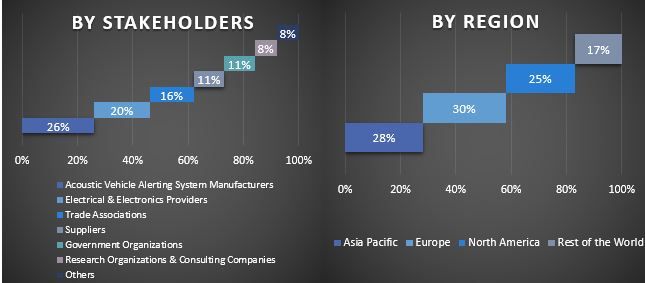
Ingegneria del mercato
La tecnica di triangolazione dei dati è stata impiegata per completare la stima complessiva del mercato e per arrivare a numeri statistici precisi per ogni segmento e sottosegmento del mercato globale dei sistemi di allarme acustici per veicoli elettrici. I dati sono stati suddivisi in diversi segmenti e sottosegmenti dopo aver studiato vari parametri e tendenze nelle aree del tipo di veicolo, del tipo di propulsione e del canale di vendita nel mercato globale dei sistemi di allarme acustici per veicoli elettrici.
L'obiettivo principale dello studio sul mercato globale dei sistemi di allarme acustici per veicoli elettrici
Le tendenze di mercato attuali e future del mercato globale dei sistemi di allarme acustici per veicoli elettrici sono state individuate nello studio. Gli investitori possono ottenere informazioni strategiche per basare la propria discrezionalità per gli investimenti sull'analisi qualitativa e quantitativa eseguita nello studio. Le tendenze di mercato attuali e future hanno determinato l'attrattiva complessiva del mercato a livello regionale, fornendo una piattaforma per il partecipante industriale per sfruttare il mercato non sfruttato per beneficiare di un vantaggio di first-mover. Altri obiettivi quantitativi degli studi includono:
- Analizzare le dimensioni del mercato attuali e previste del mercato dei sistemi di allarme acustici per veicoli elettrici in termini di valore (USD). Inoltre, analizzare le dimensioni del mercato attuali e previste di diversi segmenti e sottosegmenti.
- I segmenti nello studio includono le aree del tipo di veicolo, del tipo di propulsione e del canale di vendita.
- Definire e analizzare il quadro normativo per i sistemi di allarme acustici per veicoli elettrici
- Analizzare la catena del valore coinvolta con la presenza di vari intermediari, insieme all'analisi dei comportamenti dei clienti e dei concorrenti del settore.
- Analizzare le dimensioni del mercato attuali e previste del mercato dei sistemi di allarme acustici per veicoli elettrici per la regione principale.
- I principali paesi delle regioni studiati nel rapporto includono Asia Pacifico, Europa, Nord America e il resto del mondo
- Profili aziendali del mercato dei sistemi di allarme acustici per veicoli elettrici e le strategie di crescita adottate dagli operatori di mercato per sostenere il mercato in rapida crescita.
- Analisi approfondita a livello regionale del settore.
Domande frequenti FAQ
D1: Qual è la dimensione attuale del mercato e il potenziale di crescita del mercato dei sistemi di allerta acustico-elettrici per veicoli?
Q2: Quali sono i fattori trainanti per la crescita del mercato dei sistemi di allerta acustico-elettrici per veicoli?
Q3: Quale segmento detiene la maggiore quota di mercato dei sistemi di avviso acustico per veicoli elettrici per Tipo di Veicolo?
Q4: Quali sono le tecnologie emergenti e le tendenze nel mercato dei sistemi di allerta acustica per veicoli elettrici?
Q5: Quale regione dominerà il mercato dei sistemi di allerta acustica per veicoli elettrici e ibridi?
Correlati Report
I clienti che hanno acquistato questo articolo hanno acquistato anche

